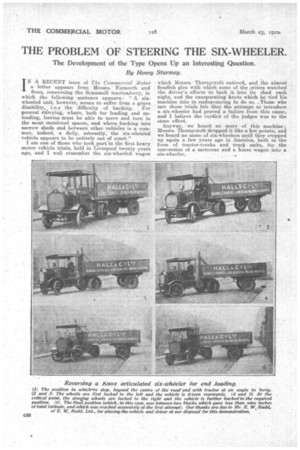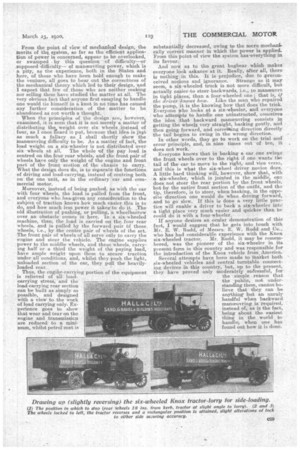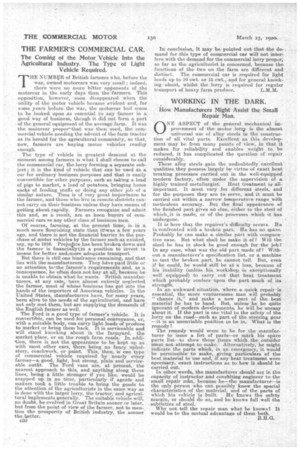THE PROBLEM OF STEERING THE SIX-WHEELER.
Page 14

Page 15

Page 16

If you've noticed an error in this article please click here to report it so we can fix it.
The Development of the Type Opens Up an Interesting Question. By Henry Sturmey.
IN A RECENT issue of The Commercial Motor a letter appears from Messrs. Famorth and Sons, concerning the Scammell tra,cto*lorry, in which the following sentence appears: "A sixwheeled unit, however, seems to suffer from a grave disability, i.e.r the difficulty of backing. For general marrying, .where, both for loading and unloading, lorries, Must be able to move and turn in the most restricted spaces, and where backing into narrow sheds and between other vehicles is a cornmen, indeed, a daily, micessity, the six-wheeled vehicle appears to be entirely out of court," I am one of those who took part in the first heavy motor vehicle trials, held in Liverpool twenty years ago, and I well remember the six-wheeled wagon which Messrs. Thornycroft entered, and the almost fiendish glee with which some of the ,critics watched the driver's efforts to back it into its shed each night, and the exasperating knots which he tied his machine into in endeavouring to do so. ,Those who saw those trials felt that the attempt to introduce a six-wheeler had proved a failure from this cause, and I believe the verdict of the judges was to the same effect.
Anyway, We heard no more of this machine; Messrs. Thornycroft dropped it like a hot potato, and we heard no more of six-wheelers until they cropped up again a few years ago in America, both in the form of tractor-trucks and truck units, for the conversion of motorcar and a horse wagon into a six-wheeIer.
From the point of view of mechanical design, the Merits of the system, so far as the efficient application of power is concerned, appear to be overlooked, or swamped by this question of difficulty—or supposed difficulty— of manceuviing power, which is a pity, as the experience, both in the States and. here, of those who have been bold enough to make the venture, all goes to bear out the correctness of the mechanical theory which led to their design, and I expect that few of those who are neither making nor selling them have studied the matter at all. The very obvious fact that anyone first essaying to handle one would tic himself in a knot in no time has caused any further consideration of the matter to be abandOned as not worth a thought.
When the principles of the design are, however, examined, it is seen that it is not merely a matter of distributing the weight over six wheels instead of four, as I once Itard it put, because that idea is just as much a fallacy as I shall shortly show the manmuvring difficulty to be. As a matter of fact, the load weight on a six-wheeler is not distributed over six wheels at all. The whole ,of the pay load is centred on the„ four rear wheels, and the front pair of wheels have only the weight of the engine and front part of the front section of the chassis to carry. What the design does do, is to -Separate the functions of driving and load-carrying, instead of centring both on the one unit, as in the ordinary car and commercial motor.
• Moreover, instead of being pushed, as with the car with four wheels, the load is pulled from the front, and everyone who hasagiven any consideration to the subject of tractien knows how much easier this is to do, and how much less power it takes to do it. ,The old illustration of pushing, or pulling, a wheelbarrow over an obstacle comes in here. In a six-wheeled machine, then, the load is carried on the, four rear wheels, and is pulled by the forward pair af those, wheels, i.e., by the centre pair of wheels of the set. The front pair of wheels of all serve only to carry the engine and steer the vehicle. The engine supplies power to the middle wheels, and these wheels, carrying half or athird the weight of the paying load, • have ample weight upon them to secure, traction under all conditions, and, whilst they push the light, unloaded section of the ear, they pull the' heavilyloaded rear.
• Thus, the engine-carrying portion of the equipment is relieved of all load_ carrying stress, 'and the load-carrying rear section can be built as simply as possible, and designed with a view to the work of load carrying only. Ex perience goes to show that wear and tear on the
engine and transmissicai are reduced to a minimum, whilst petrol-cost is
substantially decreased, owing to the mere mechanically correct manner in which the power is applied. From this point of view the system has-eVerything in its favour.
And now as to the great bugbear which makes everyone look askance at it. Really, after all, there is nothing in this. It is prejudice, due to .preconceived notions and ignorance. Strange as it may seem, a six-wheeled truck is not more difficult, but actually easier -to steer-backwards, i.e., to manceuvre in tight places; than a four-wheeled one ; that is, if the driver knows how. Like the man who repaired the pump, it is the knowing. how that does the trick. Everyone who looks' at a six-wheeler, and everyone who attempts tohandle one uninstructed, conceives the idea that backward .manceuvring consists in getting the wheels very straight, backing gently, and then going forward, and correating direction directly the tail be-gins to swing in the wrong direction.
In other words, they go to work on the trial and error principle, and, n nine times out of ten, it
does not -work. .
Everyone knows that in backing a car one swings the frout -wheels over to the right if one wants. the tail of the car to move to the right, and vice versa, and this is what the six-wheel driver novice does. A little hard thinking will, however, show that, with a six-wheeler, which is jointed in the middle, one does not steer the rear portion by the front wheels, but hy the entire front section of the outfit, and the tip, therefore, is to steer, when backing, in the opposite direction one would do when driving forward, and tO 'go slow. If this is done a very little practice will enable a driver to back a, six-wheeler into a tight place• very niuch easier and quicker than he
could do it with a four-wheeler. •
If anyone desires an ocular demonstration of this fact, Iwould suggest that he gets into, touch with Mr. E. W. Rudd,' of -Messrs; E. W. Rudd and Co., who has had considerable experience with the Knox six-wheeled tractor. Mr. Rudd, it may be remembered, was the pioneer of the Six-wheeler in its present form in this country and was responsible for the introduction of the Knox vehicle from America.
Several attempts have been made to Market both six-wheeled vehicles and central turntable connecting devices in this country; 'hut, up tothe present, they have proved only moderately suecessful, for • the simple reason that the -public, not under
standing them, cannot believe that they, can be anything' but an unruly handful when backward manceuvring is required, instead of, as is -the fact, being about the easiest thing in the world to handle, when one has found out how it is done.
THE FARMER'S COMMERCIAL CAR.
The Coming of the Motor 'Vehicle Into the Agricultural Industry. The Type of Light Vehicle Required. THE .NUMBVR of British farmers wha, before the war, owned motorcars was very small; indeed, . there were no more bitter opponents of the motorcar in the early days than the farmers. This opposition, however, 'soon disappeared when the utility of -the motor vehicle became. evident and, for
same years before the war, the motorcar had come to be looked upon as essential to any farmer in a good way of business, though it did: not form a part of the general equipment of the average farm. rt was the motorcar proper-that was then used, the eornmercial vehicle needing the advent of the farm tractor as its herald for the agricultural community, so that, now, farmers are buying. motor vehicles re-archly enough. .
The type of vehicle in greatest demand at the . moment among farmers is what I shall choose to call the commercial car, the lorry forming a separate sub
ject; it is the kind of vehicle that can be used as a car for ordinary business purposes and that is easily convertible for other Purposes, such as taking a load of pigs to market, a load of potatoes, bringing home sacks of feeding stuffs or doing any other job of a similar nature. Time is of very great importance to the farmer, and those who live in remote districts cannot carry on their business unless they have means of getting about rapidly. Farmers recognize and admit this and, as a result, are as keen buyers of cornmereial cars as any other class a business men. Of course, farming, at the present time, is hi_ a much more flourishing state than itwas a few years
ago, and there. is not the financial barrier to the purchase of meter vehicles by the farmer sucleas existed, say, up to 1916. Prejudice has been broken down and the farmer is financiallyein a position to invest in means for, better andf-more adequate transport. '
But there is still one hindrance remaining, and that lies with theark-anufacturers, They have paid little or noattention tol-the farmer's requirements and, as a Consequence, he often does not buy at all, because he is unable to obtain what he wants. "British manufac turers, at any rate, have, almost entirely neglected the farmer, most of -whose business has got into the hands of the imparters of American vehicles. In the United States, Manufacturers have, for many years, been alive to the needs of the agriculturist, and have not only met them, "but -are supplying the demands of the English farmer as well. The Ford is .a good type of farmer's vehicle. It is convertible, can be used for personal conveyance, or with a suitable body, can carry light loads of produce to market or bring them back. It is serviceable and will stand knocking about in the farmyard, the market place, or on the rough farm roads. In addi tion, there is not the appearance to be kept up as with most other cars, there being no fancy upholstery, coachwork, or paint. This, then, is one type of commercial vehicle required by nearly every
farmer—a. good, light, but strong, plain and serviceable outfit. The -Ford vans are, at present, the
nearest approach to this, and anything along these lines, being a little stronger if you like, would be snapped up in no time, particularly if agents and makers took a little trouble to• bring the goads to the attention of the agriculturists in the same way as is done with the larger lorry, the tractor, and agricultural implements generally. The suitable vehicle will, no doubt, be evolved in Great Britain sooner or later, but from the point, of view of the farmer, not to -mention the prosperity of British industry, the sooner thelaetter. c30 In conclusion, it may be pointed out that -the demand for this type of commercial car will not interfere with the demand for the commercial lorry proper, so far as the agriculturist is concerned, because the functions of the two on the firm are different and distinct. The commercial car is required for light loads up to 10 cwt. or 15 cwt.,_ and for general knocking about, whilst the lorry is required for regular transport of heavy farm produce. L.31.21.
WORKING IN THE DARK.
How Manufacturers Might Assist the Small Repair Man.
ONE ASPECT of the general mechanical inaprovement'of the motor lona,is the almost
• universal -use of alloy steels in the construction of all vital parts. Excellent as this development may be from many points of view, in that it makes for reliability and enables weight to be reduced, it has complicated the question of repair
considerably. .•
These alloy steels gain the undoubtedly, excellent qualities they possess largely by virtue of exact heat treating processes carried out in the well-equipped modernfactory, often under the supervision of a highly trained metallurgist. Heat treatment is allimportant. It must vary for different steels, and for the purposes they are to serve, and it must be carried out within a narrow temperature range with meticulous accuracy. But the final appearance of the finished part gives nn clue, either to the steel of which,it is made, or of the processes which it has undergone. . It is here that the repairer's difficulty occurs. He is. confronted with a broken part. He has no spare. Probably he can make a similar part with comparative ease. But what shall he make it of? Will the steel be has in stock be good enough for the job.? In any case, what was the old part made of? Without a manufacturer's specification list, or a machine to test the broken part, he cannot tell. But, even if he could, he would still be at a loss, because of his inability (unless his workshop •is exceptionally well equipped) to carry out that heat treatment which probably confers upon the past much of its strength. In an awkward situation, where a quick repair is essential, the more venturesome man will probably "chance it," and make a new part of the best material he has to hand. But, unless he be quite ignorant of 'modern developments, he will be uneasy about it. If the part is one vital to the safety of the lorry on the road—such as part of the steering gear i —it s an unenviable position to be in. i What s the remedy? . The remedy would seem to be, for the manufacturer to issue a list of parts—or mark his spare parts list—to show those items which ,the outsider must not attempt to make. Alternatively, he might indicate the parts which, in an emergency, it would be permissible to make, giving particulars of the best material to use and, if any heat treatment were necessary, exact instructions as to how it should be carried out.
In other words, the manufacturer should act in the capacity of instructor and constrlting engineer to the small repair man, beeaaise he—the manufacturer—is the only ;person who can possibly know the special characteristics of the material, and of the parts of
which his vehicle is built. He knows the safety margin, or should do so,. and he knows full well the subtleties of steel.
Why not tell the repair man what he knows? It would be to the mutual advantage of them both. 11.11.G.


























